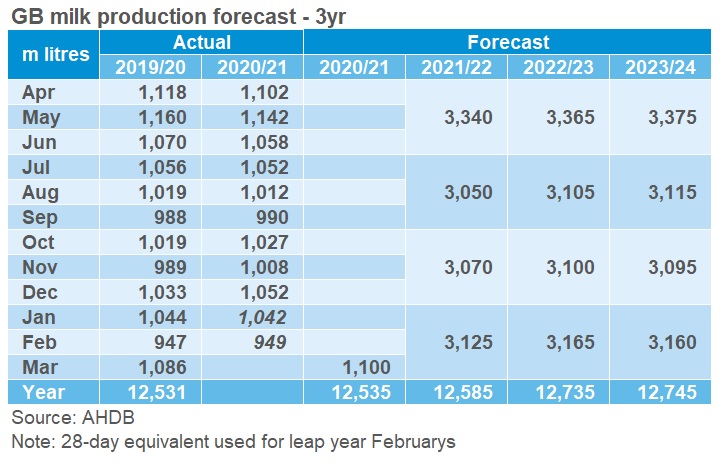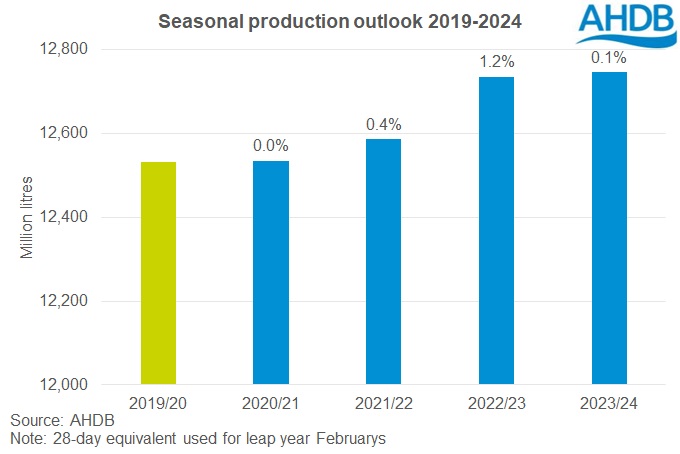What will the next 3 years hold for milk production?
Wednesday, 31 March 2021
By Kat Jack and Chris Gooderham
GB milk production could reach nearly 12.75bn litres by the 2023/24 season, our estimates suggest. This would be 1.7% higher than 2020/21, and equivalent to an extra 210 million litres. This forecast is based on trends we see in yield improvements, herd size, inseminations and youngstock.


The biggest jump in this forecast is between the 2021/22 and 2022/23 seasons, where production is expected to lift 1.2%. This is, in part, due to the uplift in youngstock recorded in 2020, as those animals will enter the milking herd in the 2022/23 season.
Discussions at the Milk Forecasting Forum indicated that the industry expects the milking herd to continue shrinking with land restrictions, including widening NVZ’s, limiting the nation’s ability to expand.
However, increases in youngstock numbers since January 2020 are flowing through into older animals. While we have reduced our expectation of the number of heifers that will make it into the milking herd, we still expect the reduction in herd size to slow compared with previous years. The GB dairy herd (2yrs+) fell 7.5% in the 3 years between January 2018 and January 2021 – roughly 2.5% a year on average. For the next 3 years, the expectation is that the decline will continue, but at a rate of less than 2% a year.
Meanwhile, yields are expected to continue improving at an average rate of 2.3% a year, as they have over the previous couple of years. The improvement in yield outweighs the reduction in herd, giving us an overall increase in production.
The next three years look set to be interesting in terms of market dynamics, particularly as our exit from the EU beds in. As our long-term outlook detailed, the international trading environment could provide challenges as well as opportunity. Closer to home, the changes to government support payments and increasing environmental scrutiny will add pressures on-farm. There are also the changing habits of British consumers to take into consideration, and finding the most profitable route for any additional milk. All of these could end up impacting milk production as farmers and processors adapt.
Find more info on our 2021/22 forecast here


Sign up to receive the latest information from AHDB.
While AHDB seeks to ensure that the information contained on this webpage is accurate at the time of publication, no warranty is given in respect of the information and data provided. You are responsible for how you use the information. To the maximum extent permitted by law, AHDB accepts no liability for loss, damage or injury howsoever caused or suffered (including that caused by negligence) directly or indirectly in relation to the information or data provided in this publication.
All intellectual property rights in the information and data on this webpage belong to or are licensed by AHDB. You are authorised to use such information for your internal business purposes only and you must not provide this information to any other third parties, including further publication of the information, or for commercial gain in any way whatsoever without the prior written permission of AHDB for each third party disclosure, publication or commercial arrangement. For more information, please see our Terms of Use and Privacy Notice or contact the Director of Corporate Affairs at info@ahdb.org.uk © Agriculture and Horticulture Development Board. All rights reserved.

